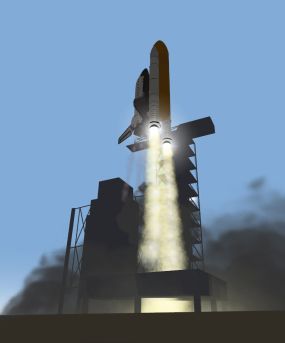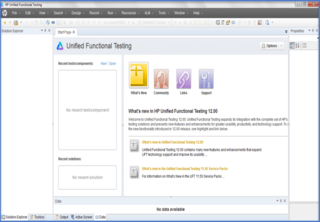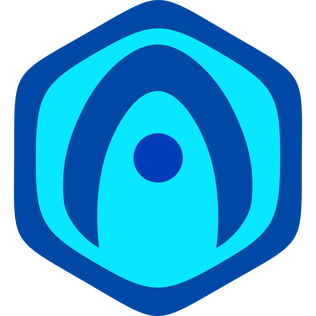
Orbiter is a space flight simulator program developed to simulate spaceflight using realistic Newtonian physics. The simulator was released on 27 November 2000; the latest edition, labeled "Orbiter 2016", was released on 30 August 2016, the first new version of the simulator since 2010. On 27 July 2021, Dr Schweiger announced to the Orbiter Community that Orbiter is being published under open source MIT license.

In computing, a visual programming language or block coding is a programming language that lets users create programs by manipulating program elements graphically rather than by specifying them textually. A VPL allows programming with visual expressions, spatial arrangements of text and graphic symbols, used either as elements of syntax or secondary notation. For example, many VPLs are based on the idea of "boxes and arrows", where boxes or other screen objects are treated as entities, connected by arrows, lines or arcs which represent relations.
In software testing, test automation is the use of software separate from the software being tested to control the execution of tests and the comparison of actual outcomes with predicted outcomes. Test automation can automate some repetitive but necessary tasks in a formalized testing process already in place, or perform additional testing that would be difficult to do manually. Test automation is critical for continuous delivery and continuous testing.
Lynx Software Technologies, Inc. is a San Jose, California software company founded in 1988. Lynx specializes in secure virtualization and open, reliable, certifiable real-time operating systems (RTOSes). Originally known as Lynx Real-Time Systems, the company changed its name to LynuxWorks in 2000 after acquiring, and merging with, ISDCorp, an embedded systems company with a strong Linux background. In May 2014, the company changed its name to Lynx Software Technologies.
Open Wonderland is a Java open-source toolkit for creating collaborative 3D virtual worlds. Within those worlds, users can communicate with high-fidelity, immersive audio, share live desktop applications and documents and conduct real business. Open Wonderland is completely extensible; developers and graphic artists can extend its functionality to create entirely new worlds including adding new features to existing worlds.

Micro Focus Unified Functional Testing (UFT), formerly known as QuickTest Professional (QTP), is software that provides functional and regression test automation for software applications and environments.

Satellite watching or satellite spotting is a hobby which consists of the observation and tracking of artificial satellites that are orbiting Earth. People with this hobby are variously called satellite watchers, trackers, spotters, observers, etc. Since satellites outside Earth's shadow reflect sunlight, those especially in low Earth orbit may visibly glint as they traverse the observer's sky, usually during twilight.
Plant Simulation is a computer application developed by Siemens Digital Industries Software for modelling, simulating, analyzing, visualizing and optimizing production systems and processes, the flow of materials and logistic operations. Plant Simulation, allows users to optimize material flow and resource utilization and logistics for all levels of plant planning from global production facilities, through local plants, to specific lines. Within the Plant Design and Optimization Solution, the software portfolio, to which Plant Simulation belongs, is — together with the products of the Digital Factory and of Digital Manufacturing — part of the Product Lifecycle Management Software (PLM). The application allows comparing complex production alternatives, including the immanent process logic, by means of computer simulations. Plant Simulation is used by individual production planners as well as by multi-national enterprises, primarily to strategically plan layout, and control logic and dimensions of large, complex production investments. It is one of the major products that dominate that market space.
OnlyOffice, stylized as ONLYOFFICE, is a free software office suite and ecosystem of collaborative applications. It features online editors for text documents, spreadsheets, presentations, forms and PDFs, and the room-based collaborative platform.
ModelCenter, developed by Phoenix Integration, is a software package that aids in the design and optimization of systems. It enables users to conduct trade studies, as well as optimize designs. It interfaces with other popular modeling tools, including Systems Tool Kit, PTC Integrity Modeler, IBM Rhapsody, No Magic, Matlab, Nastran, Microsoft Excel, and Wolfram SystemModeler. ModelCenter also has tools to enable collaboration among design team members.
The following outline is provided as an overview of and topical guide to the Perl programming language:

Stencyl is a video game development tool that allows users to create 2D video games for computers, mobile devices, and the web. The software is available for free, with select publishing options available for purchase. The software was originally called "StencylWorks" while in development and for the initial release but was later shortened to just "Stencyl".

CERES is a French space-based electronic surveillance constellation designed to collect intelligence of electromagnetic origins anywhere in the world. Consisting of three formation-flying satellites, it was developed by Airbus Defence and Space and Thales Alenia Space under the management of the CNES for the French defence procurement agency (DGA).
The Game Creators Ltd is a British software house based in Macclesfield, Cheshire, England, which specialises in software for video game development, originally for the Microsoft Windows platform. The company was established in March 1999 through a partnership between programmers Lee Bamber and Richard Vanner, who were joined by Meash Meakin in 2011 and Deborah Ascott-Jones in 2013.

Verge3D is a real-time renderer and a toolkit used for creating interactive 3D experiences running on websites.
Xiang Li is a Chinese computer hacker. He is serving a twelve-year sentence in federal prison in the United States.







